A photosensitive metallic surface has a work function . If photons of energy 2, falls on this surface, the electrons come out with a maximum velocity of 4 x m/s. When the photon energy is increased to 5, then maximum velocity of photoelectrons will be:
(1) 2 x m/s
(2) 2 x m/s
(3) 8 x m/s
(4) 8 x m/s
If the de Broglie wavelength of a proton is 1.0 x m, the electric potential through which it must have been accelerated is
(1) 4.07 x V
(2) 8.2 x V
(3) 8.2 x V
(4) 4.07 x V
If the proton and -particles are accelerated by the same potential difference, then their De-Broglie wavelength will be in the ratio of
1.
2. 2
3. 2
4. 4
If the maximum kinetic energy of emitted photoelectrons from a metal surface of work function 2.5 eV, is 1.7 eV. If the wavelength of incident radiation is halved, then stopping potential will be
(1) 2.5 V
(2) 6.7 V
(3) 5.9V
(4) 1.1 V
A radiation of energy E falls normally on a perfectly reflecting surface. The momentum transferred to the surface is-
1.
2.
3. Ec
4.
The ratio of de Broglie wavelength of -particle to that of a proton being subjected to the same magnetic field so that the radii of their paths are equal to each other assuming the field induction vector is perpendicular to the velocity vectors of the -particle and the proton is
1. 1
2. 1/4
3. 1/2
4. 2
The speed of an electron having a wavelength of the order of 1 will be
(1) 7.25 x m/s
(2) 6.26 x m/s
(3) 5.25 x m/s
(4) 4.24 x m/s
The energy that should be added to an electron, to reduce its de-Broglie wavelengths from m to 0.5 x m, will be
(1) four times the initial energy
(2) thrice the initial energy
(3) equal to the initial energy
(4) twice the initial energy
In a photoelectric experiment, the wavelength of incident radiation is reduced from 6000A to 4000A then
1. Stopping potential will decrease
2. Stopping potential will increase
3. Kinetic energy of emitted electrons will decrease
4. The value of work function will decrease
Figure represents the graph of kinetic energy (K) of photoelectrons (in eV) and frequency (v) for a metal used s cathode in the photoelectric experiment. The work function of metal is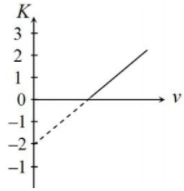
1. 1 eV
2. 1.5 eV
3. 2 eV
4. 3 eV
In a photoelectric effect experiment
1. On increasing intensity and keeping frequency fixed the saturation current decreases
2. On increasing intensity and keeping frequency fixed the saturation current remains constant.
3. On increasing intensity, saturation current may increase.
4. On increasing, frequency saturation current may increase.
The de-Broglie wavelength of a particle moving with a velocity m/s is equal to the wavelength of the photon. The ratio of the kinetic energy of the particle to the energy of the photon is (velocity of light is m/s)
1. 1/8
2. 3/8
3. 5/8
4. 7/8
The figure represents the graph of kinetic energy (K) of photoelectrons (in eV) and frequency (v) for a metal used as a cathode in the photoelectric experiment. The work function of the metal is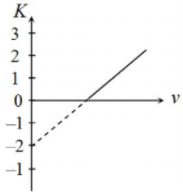
1. 1 eV
2. 1.5 eV
3. 2 eV
4. 3 eV
When a certain metallic surface is illuminated with monochromatic light of wavelength , the stopping potential for photoelectric current is 3. When the same surface is illuminated with the light of wavelength 2, the stopping potential is . The threshold wavelength for the surface for the photoelectric effect is
1.
2. 4
3. 6
4. 8
The work function of aluminium is 4.2 eV. If two photons, each of energy 3.5 eV strike an electron of aluminium, then emission of electrons will be
1. possible
2. not possible
3. data is incomplete
4. depend upon the density of the surface
A photoelectric cell is illuminated by a point source of light 1 m away. When the source is shifted to 2m then
1. each emitted electron carries one-quarter of the initial energy
2. number of electrons emitted is half the initial number
3. each emitted electron carries half the initial energy
4. number of electrons emitted is a quarter of the initial number
According to Einstein's photoelectric equation, the graph between the kinetic energy of photoelectrons ejected and the frequency of incident radiation is
1. 
2. 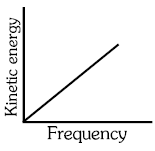
3. 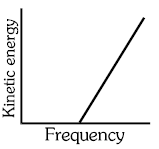
4. 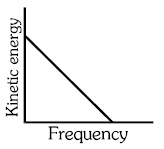
The work functions for metals A, B, and C are respectively 1.92 eV, 2.0 eV, and 5eV. According to Einstein's equation, the metals which will emit photoelectrons for radiation of wavelength 4100 Å is/are :
(1) None
(2) A only
(3) A and B only
(4) All three metals
When photons of energy hn fall on an aluminium plate (of work function ), photoelectron on maximum kinetic energy K are ejected. If the frequency of the radiation is doubled, the maximum kinetic energy of the ejected photoelectron will be:-
1. K +
2. 2K
3. K
4. K + hn
A source is producing, 1015 photons per second of wavelength 5000 Å. Another source is producing 1.02x photons per second of wavelength 5100 Å.
Then, (power of )/(power of ) is equal to :
(1) 0.98
(2) 1.00
(3) 1.02
(4) 1.04